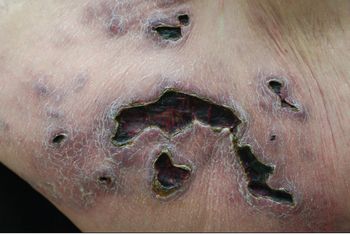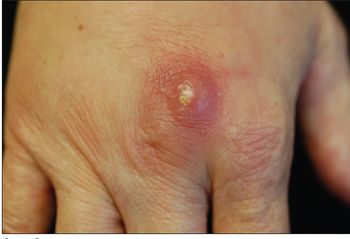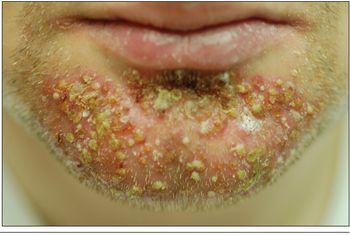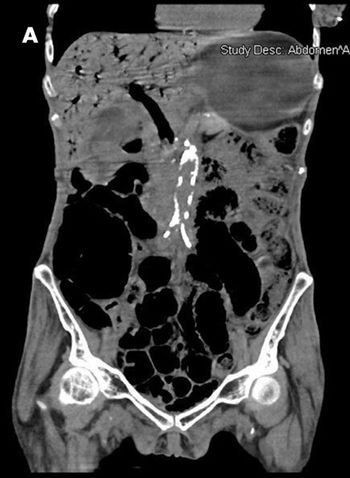
Nail lesions shown here: Onychogryphosis, pseudomonal infection, myxoid cyst, onycholisis.

Nail lesions shown here: Onychogryphosis, pseudomonal infection, myxoid cyst, onycholisis.

Contemporary “weekend warriors” are not impressed by the sporting and recreational pursuits of their parents. As a result, they have invented novel games and intensified other activities already considered rigorous a generation ago.

A 51-year-old man with a 12.5-pack-year smoking history had symptomssuggestive of gastroesophageal reflux disease for 6 weeks.

Both seasonal and H1N1 influenza pose a greater risk of severe illness and complications in patients with diabetes-and these infections can also wreak havoc with blood glucose levels.

This abdominal rash developed while a 63-year-old woman was traveling in Israel. She was admitted to the hospital, where she received intravenous antibiotics, and was discharged after 5 days. She now returns to the United States and wonders what she had, because she did not understand what the physician in Israel had told her. She has brought all of her medical records.

A 63-year-old woman presents with a tender nodule of 10 days’ duration on the dorsum of her right hand. She does not remember any specific injury, but she does do her own housework. Another physician prescribed doxycycline, 100 mg bid; however, the nodule has persisted. You order a bacterial culture.

For 1 week, a 28-year-old man has had this tender, spreading rash on his chin. He is otherwise healthy. What does this look like to you?

Children 9 years of age and younger have a much stronger immune response when they receive a second dose of 2009 H1N1 influenza vaccine, according to preliminary study results released by the NIH.

No matter what primary care demographic your practice represents, it would be most unusual not to encounter patients infected with hepatitis C virus (HCV). Since HCV infection is chronic and can lead to cirrhosis (occurring in 20% of patients over a period of 10 to 20 years), decisions regarding its management, referral, and follow-up are of the utmost importance.

Tell patients who are clamoring for the H1N1 influenza vaccine that more doses will soon be available. At a recent press conference, Thomas Frieden, MD, Director of the CDC, had this message for health care providers: “Don’t reserve available vaccine; give it out as soon as it comes in, because more is on the way.”

Recently, President Obama declared that the 2009 H1N1 influenza pandemic is a national emergency.

Imaging experts are lining up to caution physicians not to read too much into study findings suggesting that chest CT is better than general radiography for examining A-H1N1 flu patients.

Caution patients to beware of buying H1N1 influenza remedies from Internet sites.

The CDC’s Advisory Committee on Immunization Practices recommends that children aged 6 months to 9 years receive 2 doses of influenza A (H1N1) 2009 monovalent vaccine; the doses should be given about 4 weeks apart.

Lung disease was the most common underlying condition in a British study of 192 patients who had been admitted to the hospital because of complications related to H1N1 influenza.

THE CASE: A 77-year-old woman who has had shortness of breath and intermittent left flank pain for the past 2 to 3 days is brought by her family for evaluation. The dyspnea worsens when she lies down. She denies chest pain, back pain, and syncope. She has also had mild nonbloody diarrhea of 2 days’ duration but no vomiting or oral intake intolerance.

A 70-year-old woman with poorly controlled type 2 diabetes mellitus (hemoglobin A1c, 12.5%) and hypertension was brought to the emergency department for evaluation of abdominal pain and loose bowel movements.

While fishing in the Chesapeake Bay, an 81-year-old man slipped and fell into the water. Afterward, he noticed a superficial abrasion over his right knee. During the next 10 days, red bumps, pustules, and slight tenderness developed. He was treated empirically with mupirocin ointment, amoxicillin/clavulanate and subsequently with cephalexin. However, new papular lesions continued to develop adjacent to the area of involvement, which showed no signs of healing.

A 30-year-old man is admitted for profound, symptomatic anemia.

Confirming the presence of the H1N1 influenza virus in patients with suspected infection is critical to public health efforts to track, study, and contain the disease-and to the ability of clinicians to provide optimal management. Appropriate diagnostic testing is key to this process.

Not all patients in whom infection with the H1N1 influenza virus is suspected or confirmed need to be treated. Many patients with mild disease can forgo pharmacotherapy. In fact, in many cases, it may even be prudent to discourage such patients from coming into their health care provider's office, in the interest of infection control. However, all patients with severe disease and those considered at high risk for complications from seasonal influenza should be offered therapy with antiviral agents.

Before considering the infection control strategies recommended during the current H1N1 influenza pandemic, it is useful to review the transmission characteristics of influenza viruses-including H1N1-that form the basis for these strategies:

The ability to recognize cases of the new H1N1 flu and distinguish these from seasonal influenza and other respiratory illnesses is perhaps the overriding concern of primary care practitioners. Prompt and accurate identification of this entity is the key to both effective management of individual illness and effective public health measures.

Be alert for a potential dosing error when you prescribe oral-suspension oseltamivir (Tamiflu).

The first 2009 H1N1 influenza vaccine to become available will be a nasal spray that contains live attenuated virus, said CDC health officials.